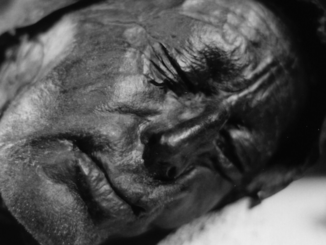
© Always Worth Saying 2022, Going Postal
As we discovered last time on Nostalgia Album, Malta is short of trees. Although my father’s cousin, Anne, and her parents Bob and Lil along with some Navy friends, did find some rare shade when pictured at the Boschetto gardens.
However, turning the page we find a coastline of arboreal abundance. Usefully, the reverse of the above print states ‘Isola Bella’. A quick scout around the coastlines of Malta and nearby Gozo proved fruitless. When casting the net further, Puffins will recall a well known Isola Bella off the Piedmont coast of Lake Maggiore in Northern Italy, just before Lombardy meets the foothills of the Alps. That wasn’t it either. Further investigation revealed the ‘beautiful island’ in question was off the northern coast of eastern Sicily, about 140 miles around the Ionian coast and across the Med from Valetta and Bob, Lil and Anne’s Sliema residence.
If proof were needed you can stand close to where the photograph was taken in the modern-day via Street View, added to which the recent photograph below proves a good match.
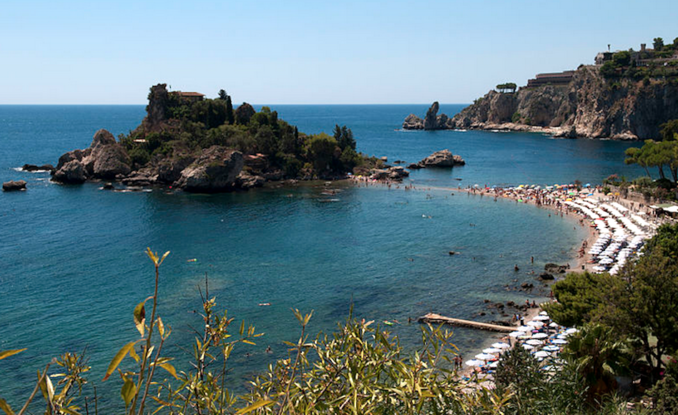
Isola Bella, Taormina, Sicily, Italy,
Anna & Michal – Licence CC BY-SA 2.0
An interesting difference is the crescent beach leading to the causeway to the island is now covered in blue umbrellas as if part of a private beach. In what appears to have been a small lagoon behind the railway halt there now sits La Plage Resort, a 5-star hotel, perhaps owners of the beach?
The railway line to the bottom right of photo number one is still intact and can be seen better here. Next to the railway, in line with the causeway is a boxy building with a pitched roof which is the old railway station on the Messina to Catania line.
The island has an interesting history. At one time owned by King Ferdinand I of the Two Sicilies, it was gifted to a nearby township and then sold to Florence Trevelyan, a gardener, builder of follies and wildlife conservationist.
A Northumberland Trevelyan, Florence was the granddaughter of a barnonet and a resident of Hallington Hall, near Corbridge, which had been bequeathed to her side of the family by a childless uncle. The hall was later owned by footballer Sol Campbell.
As a young woman, Florence toured Europe with a cousin (rumour suggested to escape a scandalous intrigue with heir to the throne Prince Edward) and settled in Sicily in 1884. After marrying a local doctor she indulged her passion for gardening follies and conservation, assembling an impressive collection of thriving exotic plants.
After her death, the property passed between a number of Trevelyans, and others, before being sold to the Region of Sicily in 1990 who preserve it as a wildlife refuge with the help of the World Wide Fund for Nature.
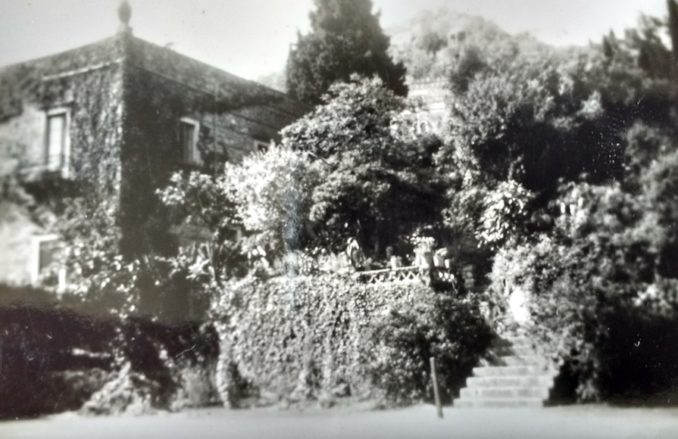
© Always Worth Saying 2022, Going Postal
The above photo appears in our album captioned ‘Part of the garden and house of the San Pancrazio Hotel where we stayed in Taormina’, that being the township on the mainland of Sicily opposite Isola Bella.
Mention of Taormina reminds us of an historic Sicilian port on the cruise circuit. These days high speed catamarans are able to offer a day trip from Malta but in the late 1940s of Rob, Lil and Anne we must assume an overnight passage with an accompanying few day’s stay of fine dining on the terrace and relaxation amongst the gardens and fountains.
Below, ‘Our table. The jar was full of lovely pink geraniums’ and ‘Anne at the fountain, it was full of goldfish’.

© Always Worth Saying 2022, Going Postal

© Always Worth Saying 2022, Going Postal
An old copy of the Pall Mall Gazette references an Admiral Markham, the second in command of the Mediterranian Fleet, who visited Taormina for health’s sake. The place is becoming a favourite resting place for tourists, the Gazette informed its readers, and is much affected by Malta’s naval officers.
“Only about 20 miles from Catania, the port occupies a picturesque site on high ground amid surroundings rich in historical interest, and commands views which enthusiasts say are unsurpassed anywhere for beauty and variety.”
San Pancrazio is the Italian name of St Pancras, a contemporary of Jesus sent to Sicily by St Peter and stoned to death by the pagans in 40 AD. Back in Blighty, the medieval London parish around St Pancras church gave its name to St Pancras railway station.
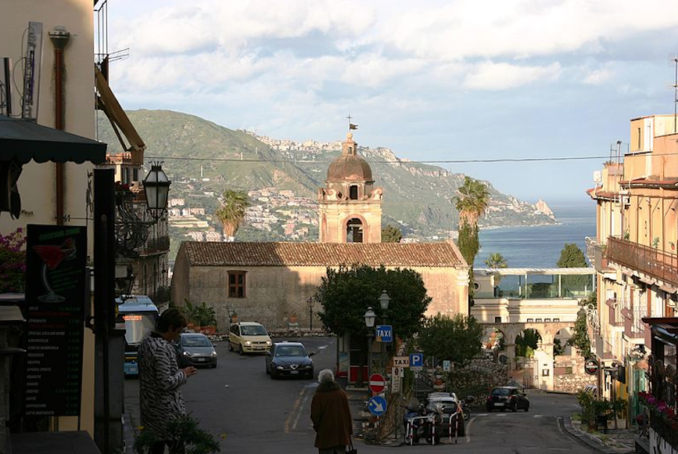
Taormina,
José Luiz Bernardes Ribeiro – Licence CC BY-SA 2.0
Taormina’s church of San Pancrazio sits atop one of the many hills the town is built around but the hotel of the same name proved difficult to find. The London Evening Standard carried a helpful information in a January 1914 Italian supplement.
Between adverts for The Grand Continental in Rome, The Royal Hotel in San Marino, the Menaggio on Lake Como and a picture of the Greek theatre of Taormina, sat a box display extolling the Hotel Villa San Pancrazio and promising the finest situation in Taormina, overlooking the straights of Messina.
All modern comforts. Beautiful garden with tennis and croquet. First class cuisine. Central heating. Large lounge and reception rooms, private suites and bath rooms. English management. Apply to Mrs Charles Dashwood.
The Dashwoods must have been long term residents of the comune as they are mentioned in Sicily in Shadow and in Sun, a Maud Howe Elliott memoir that includes a harrowing account of evacuees arriving at Taormina railway station following the Mesina Earthquake of 1908.
“As soon as the train stopped we rushed to the windows and doors with our supplies. I shall never forget the roar of this groaning humanity wildly screaming for water and doctors. People were dying every moment, stretcher after stretcher was brought in and gently laid down in the station. Dr. and Mrs. Dashwood (English residents of Taormina) were angels in the work of rescue; they brought four babies into the world at the station. We turned the place into a hospital in the twinkling of an eye; soon the building was packed with the injured and dying.”
As well as bordering the coast of the Ionian sea and the Strait of Messina, Taormina is close to Mount Etna and the Messina-Taormina fault line. Three days after Christmas Day 1908, between 75,000 and 82,000 lives are thought to have been lost with Sicily’s Messina and the Italian mainland’s Reggio Calabria being almost destroyed. As such, it is the most destructive earthquake ever to strike Europe. Minutes later, a 40-foot high tsunami swept ashore on both sides of the straights of Messina causing more damage.
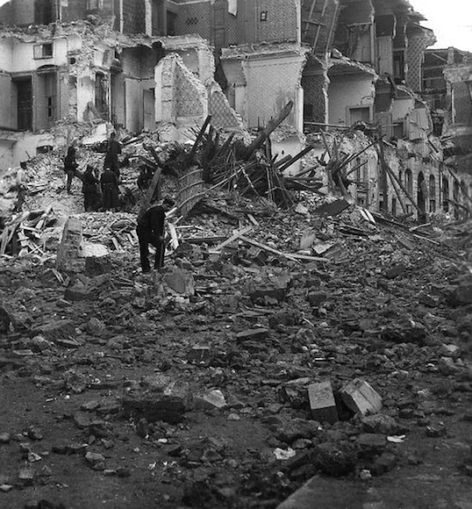
Wrecked buildings after the earthquake in Messina ,
Luca Comerio – Public domain
Armed with the complete name, I was able to locate the hotel. Sitting between the curving mountain thoroughfares on the terraces between Viale St Pancrazio and Via Luigi Pirandello, and just north of the Greek amphitheatre, it is now in a sad state of disrepair.
In this view, you can see the property from the same angle as the Nostalgia Album camera. The building with the arched windows and flat roof is the property behind the San Pancrazio, with the villa itself out of sight to the left.
That other building is now the Hotel Villa Nettuno. A tiled mural between its lower story windows shows Neptune spearing a sea monster. Standing outside and looking down the terraces we can see the roof of the dilapidated Villa San Pancreazio compensated by a magnificent view of the bay.
The gardens appear to be not only derelict but dug up. The Italian newspapers report that the once fine hotel went bankrupt, changed hands many times during a legal quagmire and became the site of an archaeological dig that exhumed a fine Roman villa but obliterated much of the gardens, terraces, palms and pond.
The fate of the Hotel Villa San Pancrazio reminds us all good things must come to an end, as did Anne’s family’s posting to Malta. On 30th July 1949, they arrived back in Southampton on a shipping service from Port Said which had made a port of call in Malta. I wondered if Taormina might have been another port of call on the way home but on the reverse of the photos sits the familiar ‘Printed by Vella’s Studios’ stamp shows Anne and her parents were back in Sliema and having their holiday photos developed on Prince of Wales Street.
Although en route to Southampton their forward address in the north of England, the family were to be posted abroad again soon and receive some adventurous mystery visitors.
Find out more next time on Nostalgia Album!
© Always Worth Saying 2022



